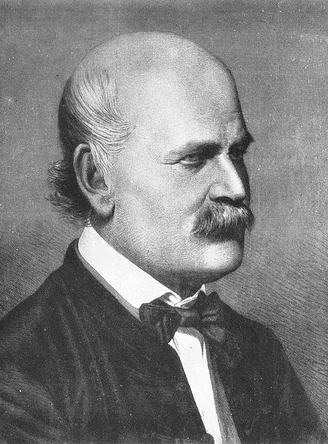Ignaz
Semmelweis, everyone!
It’s time for your monthly COVID column, and Ignaz Semmelweis isn’t a strange Lewis-Lusso holiday greeting (yet), but a true hero of healthcare.
Whether you are still worried about COVID, over it for myriad reasons, or develop a blank, thousand-yard stare when you have to think about it, I hope you’ll still find value in this quick trip through history.
Ignaz Semmelweis was a Hungarian doctor in the mid-1800s, and he noticed a problem in the two maternity wards at his teaching hospital. Between 1840 and 1846, the maternal mortality rate for the midwives’ ward was 36 per 1000 births, while the mortality rate for the doctors’ ward was 98 per 1000 births.
I’ll resist making the easy doctor joke to continue the tale: Semmelweis found that the doctors sometimes delivered babies after performing autopsies. After instituting a handwashing policy (not in general mind you, just after autopsies) the mortality rate for the doctors dropped to the same level as the midwives.
Medical professionals kicked this idea back and forth for a while before finally deciding that regular hand washing was a good idea, and instituting it as a standard … over a hundred years later, in the 1980s!
This is why I get people who don’t fully embrace COVID protocols like masking, vaccination and ventilation. In fact, if you promise to wash your hands regularly, you will be taking the most important step to not getting sick in most circumstances. Unfortunately, most of us are TERRIBLE about hand hygiene.
A lot of groups have looked at hand hygiene compliance, through surveys and observation. The areas that SHOULD have the highest compliance levels for hand hygiene are “hands down” healthcare and food service. It’s not offensive to ask your healthcare provider if they have washed their hands. How about the dude making your sandwich? If you’d ask that guy, ask your doctor as well.
A wise infection preventionist once told me: “Imagine everything you touch has ketchup on it, and that will keep you washing your hands regularly.”
“But Michelle, WHY do I need to wash my hands???” Welp, how do you think we get germs?
Why do some people always get a sore throat or a cold in the winter? Is it the cold weather? Going out for a minute without a coat? How about wet hair? Forgot to take your vitamin C?
Nope — colds are caused by viruses, not by being underdressed or “exposed” to the elements with wet hair. The common cold (along with some other unsavory viruses) is transmitted through the business that flies out of the noses and mouths of people who have the frequent and sudden urge to sneeze — like when they have a cold.
Some viruses stay viable (living) for hours to days on surfaces. It has been recommended that we regularly clean or disinfect “high-touch” surfaces. High-touch surfaces are just that — we touch them all of the time — doorknobs, toilet handles, phones, keyboards, refrigerator doors, light switches, countertops, etc.
Viruses land on these surfaces or hang out on the hands of those carrying them. If you wipe your nose, shake the hand of a colleague you haven’t seen in a while, then grab a cup of coffee from the break room, you’re both totally normal and spreading germs.
I challenged some people during Infection Prevention Week (SO much fun!) to “follow the germ” or count how many surfaces they had touched for the first hour of work. Then I asked them to try to count how many times they touched their faces. There were some surprises. Some studies have shown 23 face-touches per hour! Yikes — I’m glad I wear glasses and my mask a lot, because I probably go for the areas of my face I’m likely to deposit a germ in — my eyes, nose or mouth.
You probably won’t be able to train yourself not to touch your face — believe me, I have tried. So, the next best thing you can do is regularly wash your hands. This will not only keep your hands clean, but also keep germs off that quality mask you are breathing through.
So, what are some things that can keep us from getting sick?
- Number 1: HAND HYGIENE! Wash your hands at least 20 seconds with soap and water — or use an alcohol-based hand sanitizer — before and after eating, after using the toilet, after caring for or cleaning up after an animal, child or other dependent being or someone who is sick, before, during and after preparing food, before touching your face, after blowing your nose, coughing or sneezing, after being in public places, after touching garbage — SO many opportunities!
- Clean and disinfect high-touch surfaces (always read the manufacturer instructions for use on those cleaning products!)
- Avoid touching your eyes, nose and mouth
- Avoid close contact with people who are sick
If it’s taken you a while to get on board with preventative health measures, don’t feel bad — it took doctors over a hundred years to finally wash their hands. But now that you know, fall is a great time to start. Stay safe and healthy!
###
Michelle Lewis-Lusso (she/her) is an Infection Prevention and Control nurse at United Indian Health Services, serving the 11,000+ clients and staff at their seven area clinics. Michelle hopes you wash your hands AND don’t go out with wet hair.

CLICK TO MANAGE